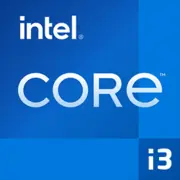Intel Core i3-14100T

Intel Core i3-14100T: Budget Processor with a Focus on Energy Efficiency
Guide for Those Seeking a Balance Between Performance and Energy Savings
Key Specifications: Architecture, Process Technology, and Key Features
Raptor Lake: Evolution of Hybrid Architecture
The Intel Core i3-14100T is built on the Raptor Lake architecture (13th generation), which is an optimized version of Alder Lake. Unlike the higher-end models with hybrid cores (P-Core and E-Core), the i3-14100T features only 4 performance cores (P-Core) with Hyper-Threading support (8 threads). This simplifies the structure while retaining the advantages of the new architecture: improved IPC (instructions per cycle) and efficient task distribution through Intel Thread Director technology.
Intel 7 Process Technology: Energy Efficiency at the Forefront
The chip is manufactured using Intel 7 (10nm Enhanced SuperFin) standards, ensuring reduced power consumption without sacrificing performance. As a result, the processor operates with a TDP of just 35 W, making it ideal for compact systems and PCs with passive cooling.
Performance: What to Expect?
In Cinebench R23 tests, the i3-14100T scores around 7000 points in multi-threaded mode, which is 15% higher than the i3-12100T (Alder Lake). For everyday tasks—office applications, browsing with multiple tabs, streaming video—this is more than sufficient. However, in heavy workloads (such as rendering in Blender), the 4 cores may become a bottleneck.
Key Features
- Support for PCIe 5.0: Ensures compatibility with the latest SSDs and graphics cards (though for the i3, this is more of a "future-proofing" feature).
- Intel UHD Graphics 730: Integrated graphics with 24 execution units can handle 4K video and less demanding games like CS:GO (60 FPS on low settings).
- Intel Technologies: Quick Sync Video for accelerated video encoding and AV1 decoding support.
Compatible Motherboards: Socket and Chipsets
LGA 1700: Versatile Socket
The processor uses the LGA 1700 socket, compatible with 600 and 700 series chipsets:
- H610: Budget option for basic builds. No overclocking, limited PCIe 4.0 support. Example: ASUS Prime H610M-E.
- B660/B760: Optimal choice. Features PCIe 4.0 and USB 3.2 Gen 2x2. Suitable for upgrades (e.g., MSI PRO B760M-A).
- H770/Z790: For enthusiasts, but excessive for the i3-14100T.
Selection Features
- BIOS and Compatibility: Some H610/B660 boards require firmware updates to work with Raptor Lake.
- Form Factor: For compact PCs, consider Mini-ITX (e.g., ASRock B760M-ITX/D4).
Supported Memory: DDR4 vs. DDR5
The processor is compatible with DDR4-3200 and DDR5-4800, but the specific type depends on the motherboard. For budget builds, DDR4 is more economical:
- 16 GB DDR4-3200 (2x8 GB) is optimal for most tasks.
- DDR5 is relevant if an upgrade to more powerful CPUs is planned in the future.
Tip: Always use dual-channel mode—this can provide up to a 20% boost in games and applications.
Power Supply Recommendations
With a TDP of 35 W and no discrete graphics card, the system will suffice with a PSU rated at 300–400 W (e.g., be quiet! Pure Power 11 400W). However, if a GPU is planned:
- For RTX 3050 or RX 6600, choose a PSU rated at 500–550 W (Corsair CX550M).
- Ensure it has an 80 Plus Bronze certification or higher.
Pros and Cons of the Intel Core i3-14100T
Advantages
- Energy Efficiency: Ideal for mini-PCs and quiet systems.
- Low Price: 20-30% cheaper than Ryzen 5 7600.
- Integrated Graphics: UHD 730 replaces the basic graphics card.
Disadvantages
- 4 Cores: Multi-tasking is limited when working with "heavy" software.
- No Overclocking: The multiplier is locked.
- DDR5 is more expensive: Compared to AMD Ryzen 7000 (which only supports DDR5).
Usage Scenarios
Office and Multimedia
- Document work, video conferencing, 4K streaming—the processor handles tasks without lag.
- Example: Connecting two monitors via HDMI and DisplayPort, working in Photoshop + browser + Slack.
Gaming
- Without a discrete graphics card: GTA V (720p, low settings) — 40–50 FPS.
- With GPU (e.g., GTX 1660 Super): Fortnite (1080p, medium settings) — 60+ FPS.
Home Server or NAS
Low power consumption and virtualization support (VT-x, VT-d) make it an excellent choice for home hosting.
Comparison with Competitors
AMD Ryzen 5 5600G
- Pros: 6 cores/12 threads, Vega 7 (better graphics).
- Cons: Higher TDP (65 W), no PCIe 5.0.
- Conclusion: Ryzen is better for gaming without a discrete card; i3 is for energy-efficient systems.
Intel Core i5-13400T
- Pros: 10 cores (6P + 4E), higher performance.
- Cons: 40-50% more expensive.
- Conclusion: i5 is a relevant choice if the budget allows.
Practical Assembly Tips
1. Cooling: The boxed cooler is sufficient, but for complete silence, choose the Noctua NH-L9i.
2. Case: Mini-ITX (Fractal Design Node 304) or compact Micro-ATX.
3. Storage: PCIe 4.0 NVMe (WD Blue SN580) will speed up system boot times.
4. BIOS Optimization: Enable power-saving mode to reduce TDP to 25 W (if maximum performance is not required).
Final Conclusion: Who is the i3-14100T For?
This processor is an excellent choice for:
- Office PCs: Quiet, compact, and cost-effective.
- Home Media Centers: 4K streaming, HTPC.
- Budget Gaming Systems: Paired with an entry-level discrete graphics card.
- Servers: Low power consumption + ECC memory support (on some motherboards).
Why choose it? The low price, modern technologies (PCIe 5.0, DDR5), and energy efficiency make the i3-14100T a flexible solution for those who are not ready to overpay for excess power.
Basic
CPU Specifications
Memory Specifications
GPU Specifications
Share in social media
Or Link To Us
<a href="https://cputronic.com/cpu/intel-core-i3-14100t" target="_blank">Intel Core i3-14100T</a>